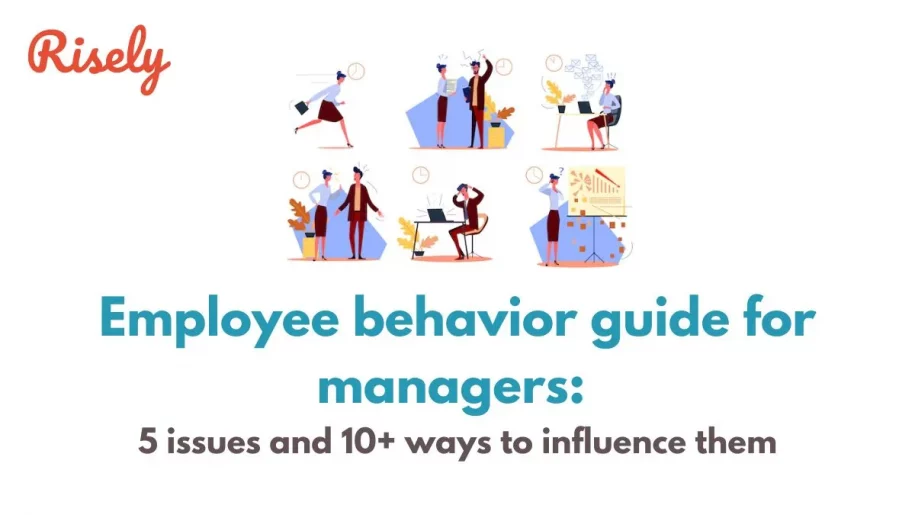Employee behavior guide for managers: 5 issues and 10+ ways to influence them
The behavior of employees in an organization can make or break its success. Positive employee behavior can increase productivity, job satisfaction, and a positive work environment. On the other hand, negative employee behavior can have detrimental effects on the company’s culture and bottom line. This blog post will dive deep into employee behavior, its importance in the workplace, and how it impacts an organization. We will also look at common employee behavior issues and discuss strategies organizations can implement to promote desirable behaviors. Lastly, we will explore how learning and development programs can be leveraged to improve employee behavior. Read on to learn more about the good and bad of employee behavior in the workplace.What is Employee Behavior, and Why is it Important?
Employee behavior refers to the actions, attitudes, and conduct of individuals in the workplace. It encompasses how employees interact with their colleagues, supervisors, and the organization. Employee behavior can be observed in various aspects, including punctuality, teamwork, communication, work ethics, and adherence to company policies and values. Employee behavior is essential for several reasons:- Organizational Culture: Employee behavior plays a significant role in shaping an organization’s culture. Employees exhibiting positive behavior, such as teamwork and respect, help create a positive and inclusive work environment. Conversely, negative behavior can lead to a toxic or unhealthy workplace culture. A strong and positive culture is vital for company’s to achieve success and tackle uncertainties.
- Productivity: Behavior directly affects productivity. Employees who are punctual, motivated, and focused on tasks are more likely to contribute to the organization’s success. In contrast, disruptive or uncooperative behavior can hinder productivity and affect the quality of work.
- Team Dynamics: Collaboration and teamwork are often critical for achieving organizational goals. Positive employee behavior, such as effective communication and cooperation, is essential for building strong team dynamics which then leads to a healthy work environment for all.
- Customer Relations: Employee behavior can significantly impact customer satisfaction for businesses that interact with customers. Polite, helpful, and responsive employees can enhance the customer experience, leading to repeat business and positive word-of-mouth.
- Compliance and Ethics: Adherence to company policies and ethical standards is crucial for legal and ethical reasons. Unethical behavior, such as fraud or harassment, can lead to legal consequences and damage the organization’s reputation.
Factors that Influence Employee Behavior
Here are five key factors that can influence employee behavior. These factors collectively shape how employees behave and impact their interactions, productivity, and overall organizational contribution.- Leadership and Management Style: The behavior of leaders and managers can strongly influence how employees behave. Supportive and inspirational leadership can foster positive behavior, while autocratic or unsupportive management may lead to negative behavior.
- Organizational Culture and Values: An organization’s culture and values shape its employees’ behavior. A culture that values collaboration and innovation will encourage behaviors that align with these values.
- Individual Attitudes and Beliefs: Employees’ attitudes, values, and beliefs significantly affect their behavior at work. Positive attitudes and strong alignment with organizational values can lead to constructive behavior.
- External Factors: Economic conditions, market competition, and regulatory requirements can impact employee behavior. For example, economic stability and industry competitiveness can influence employee motivation and risk-taking behavior.
- Workplace Environment: The physical and social aspects of the workplace environment affect employee behavior. A comfortable physical environment and positive social interactions can promote desirable behavior patterns.
Other Interesting Reads
Common Employee Behavior Issues in the Workplace
Employee behavior issues in the workplace can significantly impact productivity, morale, and overall organizational health. Here are five common employee behavior issues:- Attendance and Punctuality Problems:
- Frequent Absenteeism: Some employees may habitually call in sick or be absent without proper notice. This can disrupt workflow and place additional burdens on other team members.
- Chronic Lateness: Employees who consistently arrive late for work or meetings can disrupt schedules and negatively impact their commitment to their responsibilities.
- Poor Communication:
- Ineffective Communication: Some employees struggle with effective communication, leading to misunderstandings, misinterpretations, and a breakdown in teamwork. This can hinder collaboration and productivity.
- Lack of Transparency: Employees who withhold vital information or are not forthcoming about challenges can create trust issues within teams and with management.
- Conflict and Disruptive Behavior:
- Conflict Avoidance: Some employees may avoid addressing conflicts directly, leading to simmering tensions or passive-aggressive behavior.
- Bullying or Harassment: Workplace bullying, harassment, or discrimination can create a toxic environment and result in legal consequences for the organization.
- Performance Issues:
- Consistently Low Productivity: Employees who continually fail to meet performance expectations can affect team and organizational results.
- Quality of Work: Poor work, lack of attention to detail, or careless errors can impact the organization’s reputation and bottom line.
- Ethical Violations:
- Dishonesty and Theft: Employees engaging in dishonest behavior, such as theft or embezzlement, can harm the organization financially and damage trust among colleagues.
- Violation of Company Policies: Disregarding company policies, whether related to safety, data privacy, or ethical conduct, can expose the organization to legal and reputational risks.
Strategies for Promoting Desired Employee Behavior
Promoting desired employee behavior is crucial for creating a positive and productive work environment. Here are five strategies to encourage and promote desired behavior among employees:- Clear Expectations and Feedback:
- Set Clear Goals and Expectations: Clearly define job roles, responsibilities, and performance expectations. Make sure employees understand what is expected of them.
- Regular Feedback: Provide ongoing, constructive feedback to employees. Recognize and reward positive behavior while addressing areas that need improvement.
- Positive Reinforcement:
- Recognition and Rewards: Acknowledge and reward employees for demonstrating desired behaviors and achieving goals. This can include verbal praise, bonuses, promotions, or other incentives.
- Peer Recognition: Encourage a culture of peer recognition where employees acknowledge and appreciate each other’s contributions and behavior.
- Training and Development:
- Skills Development: Provide opportunities for employees to develop the skills necessary to exhibit desired behavior. This can include training programs, workshops, and mentoring.
- Leadership Development: Invest in training to ensure managers and supervisors model and reinforce desired behavior.
- Effective Leadership:
- Lead by Example: Leaders should model the behavior they expect from their teams. Their actions and behavior set the tone for the organization.
- Support and Guidance: Provide support and guidance to employees to help them succeed in meeting behavioral expectations. Offer coaching and mentorship when needed.
- Employee Engagement and Involvement:
- Inclusion and Participation: Involve employees in decision-making processes and initiatives. Employees who feel valued and included are more likely to exhibit positive behavior.
- Communication Channels: Maintain open lines of communication so that employees can voice their concerns and ideas, fostering a sense of ownership and commitment.
How Can Organizations Leverage learning and development to Improve Employee Behavior?
Organizations can leverage learning and development initiatives to improve employee behavior effectively. Here are several ways to achieve this:- Identify Clear Behavioral Goals: Define specific behavioral goals that align with the organization’s values and objectives.
- Customized Training Programs: Develop tailored training programs that equip employees with the knowledge and skills to exhibit desired behaviors.
- Leadership Development: Invest in leadership development to ensure managers can effectively model and reinforce the desired behaviors.
- Feedback and Assessment: Implement feedback mechanisms like 360-degree assessments to provide insights and guide individual development.
- Mentoring and Coaching: Offer mentoring and coaching programs to support employees in improving their behavior.
- Behavioral Incentives: Recognize and reward employees who consistently exhibit the desired behaviors as part of your performance management system.
- Communication and Reinforcement: Continuously communicate the importance of desired behaviors and reinforce the message through various channels.
- Measurement and Feedback Loops: Establish metrics and feedback loops to measure progress and gather employee input on program effectiveness.
Conclusion
In conclusion, employee behavior plays a crucial role in the success of an organization. Employee behavior fosters a positive work environment, improves teamwork, and enhances productivity. On the other hand, bad employee behavior can lead to conflicts, decrease morale, and hinder organizational growth. Organizations must understand the factors influencing employee behavior and implement strategies to promote desired behavior. This can be achieved through effective communication, setting clear expectations, providing feedback and recognition, and offering learning and development opportunities. Organizations can create a positive and thriving workplace by investing in employees and fostering a culture of respect and professionalism.Ace performance reviews with strong feedback skills.
Master the art of constructive feedback by reviewing your skills with a free assessment now.
Other Related Blogs
How to Set Effective Learning and Development Goals?
This blog highlights how effective learning and development goals are set, why is setting them important for your organization and what challenges you might face during this process. … Read…
Are you on track to meet your Q1 goals?
Are you on track to meet your Q1 goals? We are in the middle of the first quarter of 2024. Seems hard to believe. It surely is! ⏰ Time has…
5 Secrets Of Solid Goal Setting At Work You Can’t Miss
5 Secrets Of Solid Goal Setting At Work You Can’t Miss “I don’t focus on what I’m up against. I focus on my goals and I try to ignore the…
Understanding the world of Goal Setting Coach to reach new heights
Understanding the world of Goal Setting Coach to reach new heights Setting and achieving goals is essential for personal and organizational success in today’s fast-paced and competitive work environment. However,…


